Danish Gufran
DAILOC: Domain-Incremental Learning for Indoor Localization using Smartphones
Jun 18, 2025Abstract:Wi-Fi fingerprinting-based indoor localization faces significant challenges in real-world deployments due to domain shifts arising from device heterogeneity and temporal variations within indoor environments. Existing approaches often address these issues independently, resulting in poor generalization and susceptibility to catastrophic forgetting over time. In this work, we propose DAILOC, a novel domain-incremental learning framework that jointly addresses both temporal and device-induced domain shifts. DAILOC introduces a novel disentanglement strategy that separates domain shifts from location-relevant features using a multi-level variational autoencoder. Additionally, we introduce a novel memory-guided class latent alignment mechanism to address the effects of catastrophic forgetting over time. Experiments across multiple smartphones, buildings, and time instances demonstrate that DAILOC significantly outperforms state-of-the-art methods, achieving up to 2.74x lower average error and 4.6x lower worst-case error.
Towards Explainable Indoor Localization: Interpreting Neural Network Learning on Wi-Fi Fingerprints Using Logic Gates
Jun 18, 2025Abstract:Indoor localization using deep learning (DL) has demonstrated strong accuracy in mapping Wi-Fi RSS fingerprints to physical locations; however, most existing DL frameworks function as black-box models, offering limited insight into how predictions are made or how models respond to real-world noise over time. This lack of interpretability hampers our ability to understand the impact of temporal variations - caused by environmental dynamics - and to adapt models for long-term reliability. To address this, we introduce LogNet, a novel logic gate-based framework designed to interpret and enhance DL-based indoor localization. LogNet enables transparent reasoning by identifying which access points (APs) are most influential for each reference point (RP) and reveals how environmental noise disrupts DL-driven localization decisions. This interpretability allows us to trace and diagnose model failures and adapt DL systems for more stable long-term deployments. Evaluations across multiple real-world building floorplans and over two years of temporal variation show that LogNet not only interprets the internal behavior of DL models but also improves performance-achieving up to 1.1x to 2.8x lower localization error, 3.4x to 43.3x smaller model size, and 1.5x to 3.6x lower latency compared to prior DL-based models.
SAFELOC: Overcoming Data Poisoning Attacks in Heterogeneous Federated Machine Learning for Indoor Localization
Nov 13, 2024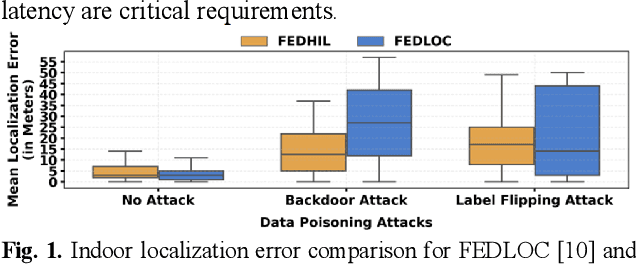
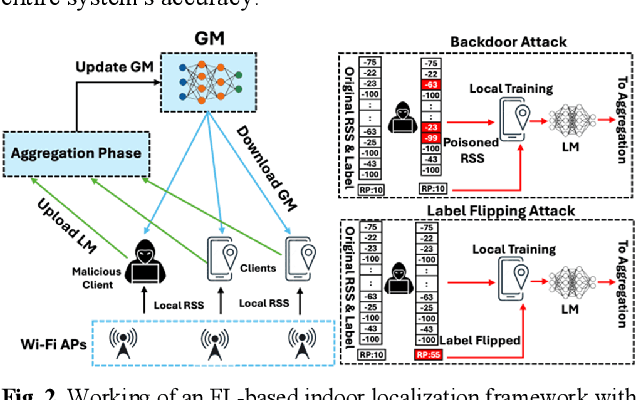
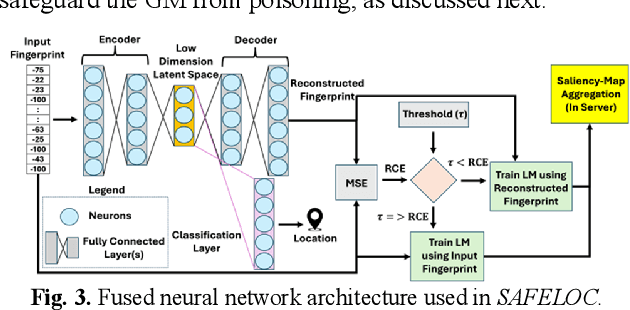
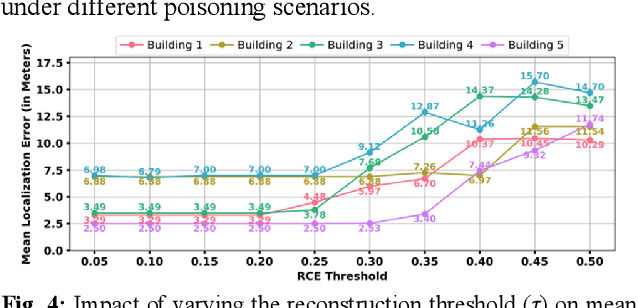
Abstract:Machine learning (ML) based indoor localization solutions are critical for many emerging applications, yet their efficacy is often compromised by hardware/software variations across mobile devices (i.e., device heterogeneity) and the threat of ML data poisoning attacks. Conventional methods aimed at countering these challenges show limited resilience to the uncertainties created by these phenomena. In response, in this paper, we introduce SAFELOC, a novel framework that not only minimizes localization errors under these challenging conditions but also ensures model compactness for efficient mobile device deployment. Our framework targets a distributed and co-operative learning environment that uses federated learning (FL) to preserve user data privacy and assumes heterogeneous mobile devices carried by users (just like in most real-world scenarios). Within this heterogeneous FL context, SAFELOC introduces a novel fused neural network architecture that performs data poisoning detection and localization, with a low model footprint. Additionally, a dynamic saliency map-based aggregation strategy is designed to adapt based on the severity of the detected data poisoning scenario. Experimental evaluations demonstrate that SAFELOC achieves improvements of up to 5.9x in mean localization error, 7.8x in worst-case localization error, and a 2.1x reduction in model inference latency compared to state-of-the-art indoor localization frameworks, across diverse building floorplans, mobile devices, and ML data poisoning attack scenarios.
SENTINEL: Securing Indoor Localization against Adversarial Attacks with Capsule Neural Networks
Jul 14, 2024



Abstract:With the increasing demand for edge device powered location-based services in indoor environments, Wi-Fi received signal strength (RSS) fingerprinting has become popular, given the unavailability of GPS indoors. However, achieving robust and efficient indoor localization faces several challenges, due to RSS fluctuations from dynamic changes in indoor environments and heterogeneity of edge devices, leading to diminished localization accuracy. While advances in machine learning (ML) have shown promise in mitigating these phenomena, it remains an open problem. Additionally, emerging threats from adversarial attacks on ML-enhanced indoor localization systems, especially those introduced by malicious or rogue access points (APs), can deceive ML models to further increase localization errors. To address these challenges, we present SENTINEL, a novel embedded ML framework utilizing modified capsule neural networks to bolster the resilience of indoor localization solutions against adversarial attacks, device heterogeneity, and dynamic RSS fluctuations. We also introduce RSSRogueLoc, a novel dataset capturing the effects of rogue APs from several real-world indoor environments. Experimental evaluations demonstrate that SENTINEL achieves significant improvements, with up to 3.5x reduction in mean error and 3.4x reduction in worst-case error compared to state-of-the-art frameworks using simulated adversarial attacks. SENTINEL also achieves improvements of up to 2.8x in mean error and 2.7x in worst-case error compared to state-of-the-art frameworks when evaluated with the real-world RSSRogueLoc dataset.
SANGRIA: Stacked Autoencoder Neural Networks with Gradient Boosting for Indoor Localization
Mar 03, 2024Abstract:Indoor localization is a critical task in many embedded applications, such as asset tracking, emergency response, and realtime navigation. In this article, we propose a novel fingerprintingbased framework for indoor localization called SANGRIA that uses stacked autoencoder neural networks with gradient boosted trees. Our approach is designed to overcome the device heterogeneity challenge that can create uncertainty in wireless signal measurements across embedded devices used for localization. We compare SANGRIA to several state-of-the-art frameworks and demonstrate 42.96% lower average localization error across diverse indoor locales and heterogeneous devices.
STELLAR: Siamese Multi-Headed Attention Neural Networks for Overcoming Temporal Variations and Device Heterogeneity with Indoor Localization
Dec 16, 2023Abstract:Smartphone-based indoor localization has emerged as a cost-effective and accurate solution to localize mobile and IoT devices indoors. However, the challenges of device heterogeneity and temporal variations have hindered its widespread adoption and accuracy. Towards jointly addressing these challenges comprehensively, we propose STELLAR, a novel framework implementing a contrastive learning approach that leverages a Siamese multi-headed attention neural network. STELLAR is the first solution that simultaneously tackles device heterogeneity and temporal variations in indoor localization, without the need for retraining the model (re-calibration-free). Our evaluations across diverse indoor environments show 8-75% improvements in accuracy compared to state-of-the-art techniques, to effectively address the device heterogeneity challenge. Moreover, STELLAR outperforms existing methods by 18-165% over 2 years of temporal variations, showcasing its robustness and adaptability.
CALLOC: Curriculum Adversarial Learning for Secure and Robust Indoor Localization
Nov 10, 2023Abstract:Indoor localization has become increasingly vital for many applications from tracking assets to delivering personalized services. Yet, achieving pinpoint accuracy remains a challenge due to variations across indoor environments and devices used to assist with localization. Another emerging challenge is adversarial attacks on indoor localization systems that not only threaten service integrity but also reduce localization accuracy. To combat these challenges, we introduce CALLOC, a novel framework designed to resist adversarial attacks and variations across indoor environments and devices that reduce system accuracy and reliability. CALLOC employs a novel adaptive curriculum learning approach with a domain specific lightweight scaled-dot product attention neural network, tailored for adversarial and variation resilience in practical use cases with resource constrained mobile devices. Experimental evaluations demonstrate that CALLOC can achieve improvements of up to 6.03x in mean error and 4.6x in worst-case error against state-of-the-art indoor localization frameworks, across diverse building floorplans, mobile devices, and adversarial attacks scenarios.
FedHIL: Heterogeneity Resilient Federated Learning for Robust Indoor Localization with Mobile Devices
Jul 04, 2023



Abstract:Indoor localization plays a vital role in applications such as emergency response, warehouse management, and augmented reality experiences. By deploying machine learning (ML) based indoor localization frameworks on their mobile devices, users can localize themselves in a variety of indoor and subterranean environments. However, achieving accurate indoor localization can be challenging due to heterogeneity in the hardware and software stacks of mobile devices, which can result in inconsistent and inaccurate location estimates. Traditional ML models also heavily rely on initial training data, making them vulnerable to degradation in performance with dynamic changes across indoor environments. To address the challenges due to device heterogeneity and lack of adaptivity, we propose a novel embedded ML framework called FedHIL. Our framework combines indoor localization and federated learning (FL) to improve indoor localization accuracy in device-heterogeneous environments while also preserving user data privacy. FedHIL integrates a domain-specific selective weight adjustment approach to preserve the ML model's performance for indoor localization during FL, even in the presence of extremely noisy data. Experimental evaluations in diverse real-world indoor environments and with heterogeneous mobile devices show that FedHIL outperforms state-of-the-art FL and non-FL indoor localization frameworks. FedHIL is able to achieve 1.62x better localization accuracy on average than the best performing FL-based indoor localization framework from prior work.
VITAL: Vision Transformer Neural Networks for Accurate Smartphone Heterogeneity Resilient Indoor Localization
Feb 18, 2023Abstract:Wi-Fi fingerprinting-based indoor localization is an emerging embedded application domain that leverages existing Wi-Fi access points (APs) in buildings to localize users with smartphones. Unfortunately, the heterogeneity of wireless transceivers across diverse smartphones carried by users has been shown to reduce the accuracy and reliability of localization algorithms. In this paper, we propose a novel framework based on vision transformer neural networks called VITAL that addresses this important challenge. Experiments indicate that VITAL can reduce the uncertainty created by smartphone heterogeneity while improving localization accuracy from 41% to 68% over the best-known prior works. We also demonstrate the generalizability of our approach and propose a data augmentation technique that can be integrated into most deep learning-based localization frameworks to improve accuracy.
Multi-Head Attention Neural Network for Smartphone Invariant Indoor Localization
May 17, 2022
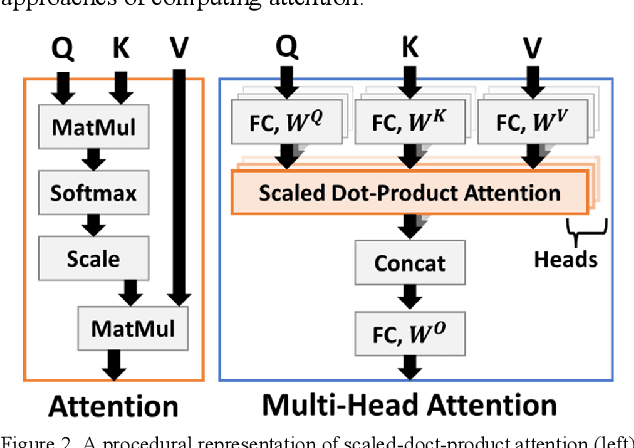
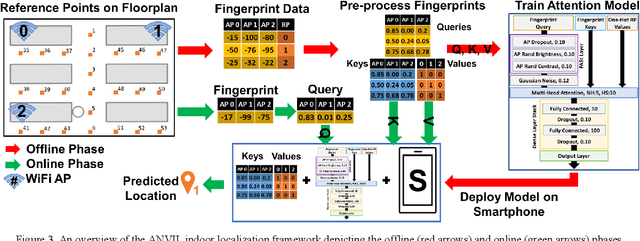
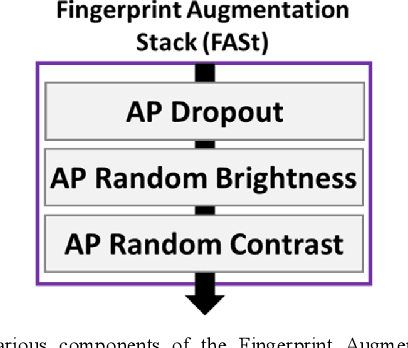
Abstract:Smartphones together with RSSI fingerprinting serve as an efficient approach for delivering a low-cost and high-accuracy indoor localization solution. However, a few critical challenges have prevented the wide-spread proliferation of this technology in the public domain. One such critical challenge is device heterogeneity, i.e., the variation in the RSSI signal characteristics captured across different smartphone devices. In the real-world, the smartphones or IoT devices used to capture RSSI fingerprints typically vary across users of an indoor localization service. Conventional indoor localization solutions may not be able to cope with device-induced variations which can degrade their localization accuracy. We propose a multi-head attention neural network-based indoor localization framework that is resilient to device heterogeneity. An in-depth analysis of our proposed framework across a variety of indoor environments demonstrates up to 35% accuracy improvement compared to state-of-the-art indoor localization techniques.
 Add to Chrome
Add to Chrome Add to Firefox
Add to Firefox Add to Edge
Add to Edge